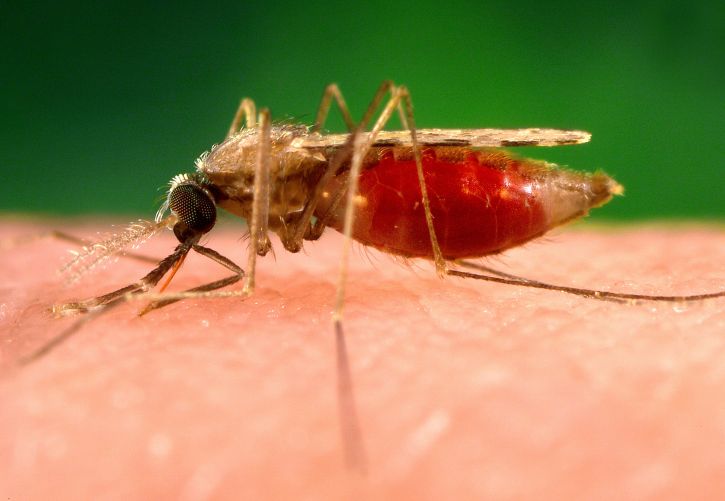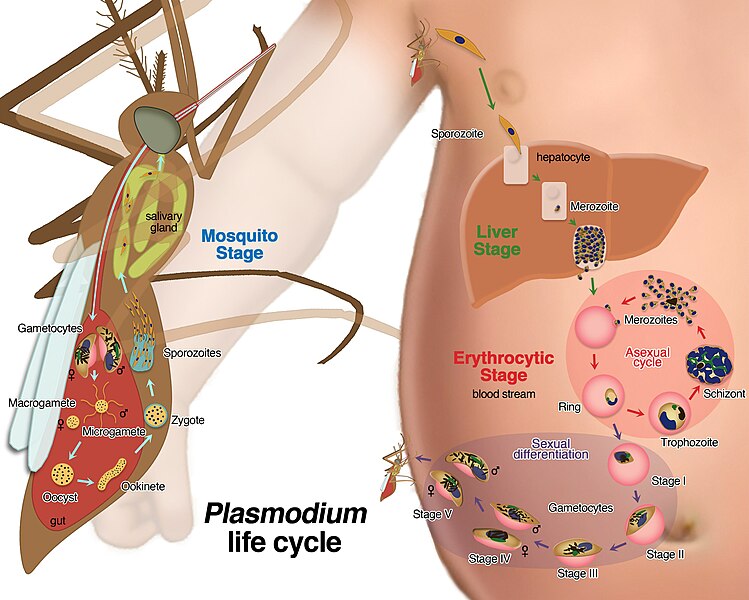The word ‘Malaria’, what does it mean? And what really strikes your mind when you hear this word? Before we start, here's a fact about Malaria “200 million people are affected by malaria each year, out of which 1 million lose their lives.” Out of these deaths, 90% of them occur in Africa. Malaria kills one child every minute in Africa. Okay, now let's dive deep into the topic.

Malaria: An Introduction
The word ‘Malaria’ is not what you think. Malaria just means “Bad air”. Well, in the early 18th-century scientist thought this mysterious disease was caused because of inhaling the bad air in the swampy areas. Later they found out this was not true at all but the name just never changed. This is the only disease known to have existed throughout the evolution of humans. We know this because we have found the oldest known malaria specimen. This specimen is about 30 million years old. How you ask? just as the movie Jurassic Park, mosquitoes well preserved in amber were found which consisted of malaria parasites.
What really is Malaria?
In simple words, Malaria is a parasitic disease that maybe sometimes fatal. These parasites are carried by a certain type of mosquito. Only the genus “Anopheles” mosquitoes can transmit this disease. And only females of these species can transmit because they feed on human blood. There are five types of parasites that affect humans: Plasmodium vivax Plasmodium ovale Plasmodium malariae Plasmodium falciparum and lastly Plasmodium knowlesi. These parasites develop and reproduce in the mosquito. When the mosquito bites a healthy person, these parasites are transmitted into the bloodstream through their salivary gland. The deadliest of these parasites is Plasmodium falciparum. But still, the deaths can be prevented if proper treatment is given on time.

Fig: Female Anopheles Mosquito (Source)
Who are at Risk?
Malaria mostly affects children. It’s because they have not developed proper immunity yet. Mostly children in Africa are affected. As mentioned above Malaria kills one child every minute in Africa.Another group that is highly at risk is pregnant women. It’s because the stage of pregnancy alters the state of immunity which makes mother prone to these infections. If a pregnant mother suffers from Malaria, it can have some serious impacts. It can lead to prematurity or low birth weight babies. Finally, another group that is at high risk are people traveling to malaria borne areas.
Some Special People are not at Risk
Yes, there are some people with a genetic disorder called sickle cell anemia who tend to stay away from disease. People with this disorder tend to survive in malaria borne areas. Why? Well, in this disorder the hemoglobin of RBC is defective. This reduces the oxygen-carrying capacity of the RBC. Since this parasite has an aerobic metabolism, it can't survive in a reduced oxygen state.
What really causes Malaria?
I have mentioned above Female mosquitoes of genus “Anopheles” feed on human blood and transmit parasites. But why are they attracted to human blood and why only females?The answer is pretty simple. Females need nutrition for the development of eggs. Generally, the smell and their compound vision attract them towards humans. When a mosquito is sucking on a blood meal, it pushes its saliva into the host. This saliva works as an anti-clotting agent and an anesthetic which prevents the person from feeling the bite while the mosquito is doing its business. Yes, the itchiness and redness is due to this leftover saliva. Also unluckily, if the mosquito is carrying a parasite, it will transmit the parasite into the blood while having its delicious blood meal. The species of the parasites are already mentioned above. The most dangerous of those species is Plasmodium falciparum. Out of all the deaths from Malaria, falciparum contributes about 90% of them.
Spread of Malaria: The Life Cycle
The Life cycle of Plasmodium is a bit complex. It involves many forms of development. Let's see what are the stages.
1.Human stage (Asexual stage)
- Exo-erythrocytic stage
- Erythrocytic stage
2.Mosquito stage (sexual stage)

fig: Plasmodium lifecycle (Source)
Human Stage: Exo-Erythrocytic Stage.
When an infected mosquito bites a healthy person, the infective stage of plasmodium namely “Sporozoites” are released into the bloodstream. Sporozoite is just a fancy name for immature parasites. These sporozoites travel through the blood and in about 30 - 40 mins reach the liver. Finally, they enter into the hepatocytes (liver cells). In the hepatocytes, they multiply asexually and form many many merozoites. All merozoites together are commonly called Shizont. Hepatocytes cannot sustain these multiplying merozoites and rupture releasing thousands of merozoites into the bloodstream. The Exo-erythrocytic stage is now completed. This total process takes about 7-10 days.
Human Stage: Erythrocytc Stage
By now there are thousands of merozoites in the blood. These merozoites starts taking over normal RBCs. These merozoites furthur divide in the RBC which leads to bursting and furthur more release of merozoites infecting more RBCs. This process keeps ongoing. Some merozoites form a ring-like structure and then convert into trophozoite. Again these trophozoites basically multiply and form more merozoites which again leads to brusting and release infecting more RBCs.Well, this keeps on repeating itself with a regular interval of time causing chills and fever at regular intervals.Some merozoites start forming sexual forms (gametocytes). Of course, there must be two gametocytes both male and female. Note: They are still inside the RBC.These gametocytes are taken by the mosquitoes when they suck on these infected RBCs.
Mosquito Stage (Sexual stage)
This stage is quite simple. The female anopheles mosquito after sucking infected blood with gametocytes digest it in the stomach. These male and female gametocytes matures to form male and female gametes. These gametes fuse together to form a zygote. Zygote is not motile so it further develops and forms Ookinete. This stage is now motiles and moves into the wall of the stomach. Later they divide and form oocyst. Oocysts rupture in about 8 - 10 days releasing thousands of sporozoites. These sporozoites somehow manage to reach the salivary glands of the mosquito and are completely ready to spread malaria.
Symptoms And Diagnosis The symptoms are normally flu-like. The classic symptoms of malaria are:
- Fever
- Chills
- Sweating
- Vomiting
The incubation period is about 9-10 days. But this time can differ in different parasites. Other symptoms include headache, diarrhea, convulsions and even coma. Signs include severe anemia and jaundice.
Fever intervals according to Parasites:
Plasmodium vivax : Every 48 hour
Plasmodium ovale : Every 48 hour
Plasmodium Malariae : Every 72 hours
Plasmodium falciparum : Every 3rd day or daily paroxysmal type.
Plasmodium knowlesi : Every 24 hours
Diagnosis is made by clinical examinations and some tests. A recent travel history is taken into consideration. Also, the Spleen and liver are palpated. If there is enlargement of Liver and spleen and other symptoms of malaria then a blood test is done to confirm the diagnosis. This blood test also shows the type of parasite and anemia.
Some Life-threatening complications of Malaria
- Cerebral Malaria
- Hemolytic anemia
- Organ failure
- Pulmonary Edema
- Coma
How to Prevent Malaria?
There are lots of ways to prevent malaria. Mosquito killing and physical preventive barriers are the most important ones. Mosquitoes can be killed by the insecticidal sprays. And bites can be prevented by using mosquito nets. Now, DDT chemical is widely used to prevent malaria. This chemical is effective for more than 6 months.Mosquitoes normally breed in the stagnant water, so these sites should be cleaned or covered with soil.Gambusia fish also called the “Mosquitofish” is widely used to prevent malaria because its main diet is mosquito larvae. This way of prevention is known as Biological control.

fig: Biological control (baby Gambusia fish) Source
And Finally Treatment
Antiparasitic Drugs are prescribed. But which type of antiparasitic drug depends on factors such as age, type of parasite, how severe the disease is and whether the patient is pregnant or not. The medicine of malaria include the following:
- Artemisinin-based combined medication also known as ACTs. This is the first-line drug for malaria. Artemisinin is combined with different drugs like lumefantrine, amodiaquine, mefloquine, piperaquine, and sulfadoxine.
- Chloroquine based therapy. This method is preferred if the patient is sensitive to other anti-malarial drugs. In the present time, the parasites are becoming resistant to this drug.
You stayed until the end. Thank you so much for reading guys hope you enjoyed it.
References:
[1] https://www.mayoclinic.org/diseases-conditions/malaria/symptoms-causes/syc-20351184
[2] https://www.cdc.gov/parasites/malaria/index.html
[3] https://www.emedicinehealth.com/malaria/article_em.htm
Originally posted here: https://steemit.com/steemstem/@idoctor/malaria-world-biggest-killer-a-deep-analysis
No comments:
Post a Comment